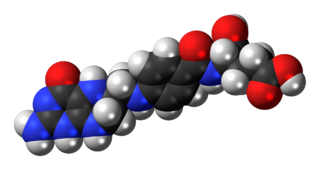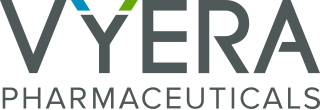
Folate, also known as vitamin B9 and folacin, is one of the B vitamins. Manufactured folic acid, which is converted into folate by the body, is used as a dietary supplement and in food fortification as it is more stable during processing and storage. Folate is required for the body to make DNA and RNA and metabolise amino acids necessary for cell division. As the human body cannot make folate, it is required in the diet, making it an essential nutrient. It occurs naturally in many foods. The recommended adult daily intake of folate in the U.S. is 400 micrograms from foods or dietary supplements.

Trimethoprim (TMP) is an antibiotic used mainly in the treatment of bladder infections. Other uses include for middle ear infections and travelers' diarrhea. With sulfamethoxazole or dapsone it may be used for Pneumocystis pneumonia in people with HIV/AIDS. It is taken orally.

Sydney Grammar School is an independent, fee-paying, non-denominational day school for boys, located in Sydney, Australia.

Trimethoprim/sulfamethoxazole, sold under the brand name Bactrim among others, is a fixed-dose combination antibiotic medication used to treat a variety of bacterial infections. It consists of one part trimethoprim to five parts sulfamethoxazole. It is used to treat urinary tract infections, methicillin-resistant Staphylococcus aureus (MRSA) skin infections, travelers' diarrhea, respiratory tract infections, and cholera, among others. It is used both to treat and prevent pneumocystis pneumonia and toxoplasmosis in people with HIV/AIDS and other causes of immunosuppression. It can be given orally or intravenous infusion.

Folinic acid, also known as leucovorin, is a medication used to decrease the toxic effects of methotrexate and pyrimethamine. It is also used in combination with 5-fluorouracil to treat colorectal cancer and pancreatic cancer, may be used to treat folate deficiency that results in anemia, and methanol poisoning. It is taken by mouth, injection into a muscle, or injection into a vein.

Sulfamethoxazole is an antibiotic. It is used for bacterial infections such as urinary tract infections, bronchitis, and prostatitis and is effective against both gram negative and positive bacteria such as Listeria monocytogenes and E. coli.

Aminopterin, the 4-amino derivative of folic acid, is an antineoplastic drug with immunosuppressive properties often used in chemotherapy. Aminopterin is a synthetic derivative of pterin. Aminopterin works as an enzyme inhibitor by competing for the folate binding site of the enzyme dihydrofolate reductase. Its binding affinity for dihydrofolate reductase effectively blocks tetrahydrofolate synthesis. This results in the depletion of nucleotide precursors and inhibition of DNA, RNA, and protein synthesis.

Etacrynic acid (INN) or ethacrynic acid (USAN), trade name Edecrin, is a loop diuretic used to treat high blood pressure and the swelling caused by diseases like congestive heart failure, liver failure, and kidney failure. A con with ethacrynic acid compared to the other loop diuretic drugs such as furosemide is that it has a significantly steep dose-response curve, which means the drug's dosing is very important as small variance in dose can cause a significant difference in the biological response.

Sulfadiazine is an antibiotic. Used together with pyrimethamine, a dihydrofolate reductase inhibitor, it is the treatment of choice for toxoplasmosis, which is caused by a protozoan parasite. It is a second-line treatment for otitis media, prophylaxis of rheumatic fever, chancroid, chlamydia, and infections by Haemophilus influenzae. It is also used as adjunct therapy for chloroquine-resistant malaria and several forms of bacterial meningitis. It is taken by mouth. Sulfadiazine is available in multiple generic tablets of 500 mg. For urinary tract infections, the usual dose is 4 to 6 grams daily in 3 to 6 divided doses.

Tetrahydrofolic acid (THFA), or tetrahydrofolate, is a folic acid derivative.

Sulfadimethoxine is a long-lasting sulfonamide antimicrobial medication used in veterinary medicine. It is used to treat many infections, including respiratory, urinary tract, enteric, and soft tissue infections and can be given as a standalone or combined with ormetoprim to broaden the target range. Like all sulfamides, sulfadimethoxine inhibits bacterial synthesis of folic acid by acting as a competitive inhibitor against PABA. It is the most common drug prescribed to dogs who have coccidiosis.

Antifolates are a class of antimetabolite medications that antagonise (that is, block) the actions of folic acid (vitamin B9). Folic acid's primary function in the body is as a cofactor to various methyltransferases involved in serine, methionine, thymidine and purine biosynthesis. Consequently, antifolates inhibit cell division, DNA/RNA synthesis and repair and protein synthesis. Some such as proguanil, pyrimethamine and trimethoprim selectively inhibit folate's actions in microbial organisms such as bacteria, protozoa and fungi. The majority of antifolates work by inhibiting dihydrofolate reductase (DHFR).
Medication costs, also known as drug costs are a common health care cost for many people and health care systems. Prescription costs are the costs to the end consumer. Medication costs are influenced by multiple factors such as patents, stakeholder influence, and marketing expenses. A number of countries including Canada, parts of Europe, and Brazil use external reference pricing as a means to compare drug prices and to determine a base price for a particular medication. Other countries use pharmacoeconomics, which looks at the cost/benefit of a product in terms of quality of life, alternative treatments, and cost reduction or avoidance in other parts of the health care system. Structures like the UK's National Institute for Health and Clinical Excellence and to a lesser extent Canada's Common Drug Review evaluate products in this way.
Sulfadoxine/pyrimethamine, sold under the brand name Fansidar, is a combination medication used to treat malaria. It contains sulfadoxine and pyrimethamine. For the treatment of malaria it is typically used along with other antimalarial medication such as artesunate. In areas of Africa with moderate to high rates of malaria, three doses are recommended during the second and third trimester of pregnancy.

Martin Shkreli is an American businessman and financial criminal. Shkreli is the co-founder of the hedge funds Elea Capital, MSMB Capital Management, and MSMB Healthcare, the co-founder and former CEO of pharmaceutical firms Retrophin and Turing Pharmaceuticals, and the former CEO of start-up software company Gödel Systems, which he founded in August 2016.

Vyera Pharmaceuticals is a pharmaceutical company incorporated in Zug, Switzerland, with offices in New York City. The company started to do business in the US as Vyera Pharmaceuticals in September 2017.
Harrow Health, formerly known as Imprimis Pharmaceuticals, is a publicly traded pharmaceutical company based in Nashville, TN.

The Four Thieves Vinegar Collective is an anarchist biohacking group founded in 2015 by Michael Laufer. They have published instructions for the "EpiPencil", an epinephrine autoinjector, and the "Apothecary MicroLab", a do-it-yourself (DIY) device intended to make a variety of medications, most notably pyrimethamine (Daraprim). They have been criticized by the medical community for causing potential harm to patients with the DIY instructions, but Laufer claims to defend people's right to attempt their own medical treatment.

Alice Elizabeth Motion is a British chemist, science communicator, and associate professor at the School of Chemistry, University of Sydney. She is the founder of the Breaking Good project which encourages high school and undergraduate students to take part in research that can benefit human health. In 2018, the Breaking Good project was a finalist on the Google.org Impact Challenge.

Matthew Houghton Todd is a British chemist and the Professor and Chair of Drug Discovery of the School of Pharmacy at University College London. He is the founder of Open Source Malaria (OSM) and his research focuses on drug discovery and development for this disease. Recently, he has expanded to other areas, particularly neglected diseases such as tuberculosis and mycetoma in the Open Source Tuberculosis (OSTB) and Open Source Mycetoma (MycetOS) project, through a collaboration with the Drugs for Neglected Diseases Initiative and Erasmus MC. In addition, he has some research activity in catalysis and methodology.



















